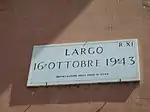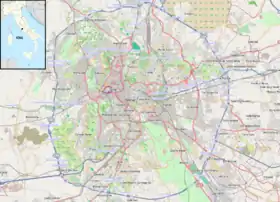Raid of the Ghetto of Rome
The Raid of the Ghetto of Rome took place on 16 October 1943.[1] A total of 1,259 people, mainly members of the Jewish community—numbering 363 men, 689 women, and 207 children—were detained by the Gestapo. Of these detainees, 1,023 were identified as Jews and deported to the Auschwitz concentration camp. Of these deportees, only fifteen men and one woman survived.
| Raid of the Ghetto of Rome | |
|---|---|
 Commemoration of the raid | |
 Raid of the Ghetto of Rome (Rome) | |
| Location | Roman Ghetto, Rome, Italy |
| Coordinates | 41°53′33″N 12°28′43″E |
| Date | 16 October 1943 |
| Target | Italian Jews and Jewish refugees |
Attack type | Arrest for deportation to extermination camps |
| Deaths | 1,007 murdered in extermination camps |
| Perpetrators | German security forces & police |
Ghetto
The Ghetto of Rome had been established in 1555. By the time of the raid, it was almost 400 years old and consisted of four cramped blocks around the Portico d’Ottavia, wedged between the Theatre of Marcellus, the Fontana delle Tartarughe, Palazzo Cenci, and the river Tiber.[2]
Prelude
When Nazi Germany occupied Rome two days after the Italian surrender on 8 September 1943, 8,000 Italian Jews were in Rome, one-fifth of all Jews in Italy. Many of those had moved south after the Allied landing, hoping to find safety from Nazi persecution.[3]
The German military commander of Rome, General Reiner Stahel, was initially wary that any action against the Jews of Rome would draw condemnation from Pope Pius XII, of which he had been warned by Bishop Alois Hudal, rector of the German church in Rome. This condemnation, however, never materialised, which has led to considerable controversy. Stahel decided against ordering deportation without official authority from the German foreign ministry. Germany's Consul-General Eitel Friedrich Möllhausen went so far as to write to Foreign Minister Joachim von Ribbentrop in order to suggest that the Roman Jews be interned in Italian camps rather than deported, but Ribbentrop never dared to act against the Sicherheitsdienst (SD), from which Stahel received his orders. The role of the German ambassador to the Vatican, Ernst von Weizsäcker, in these events remains a matter of controversy.[3]
On 26 September, Herbert Kappler, commander of the SS and the Gestapo in Rome, announced to the Jewish community in the city that unless they handed over 50 kilograms (110 lb) of gold, 200 Jewish family heads would be deported. The community delivered this sum on the deadline of midday, 28 September, with the assistance of the non-Jewish citizens of Rome. This left the Jewish community with the impression that the Germans were only after loot, especially the priceless treasures of the Biblioteca della Comunità Israelitica community library.[4]
Raid
On the morning of 16 October 1943, 365 German security and police forces (the Italian police were considered too unreliable[5]) sealed off the Ghetto, which held a large part of the Jewish community at the time, turning it into a virtual prison. Theodor Dannecker, recently appointed chief of the Judenreferat in Italy and tasked with implementing the Final Solution, the genocide of the Jews, in Italy, had ordered the Ghetto to be cleared. Some Jews in the Ghetto managed to escape over rooftops.[2]
In the raid, 1,259 people were detained, comprising 363 men, 689 women, and 207 children.[4] Afterwards, non-Jewish prisoners were released while 1,023 Jews were taken to the Collegio militare in the Palazzo Salviati in Trastevere. Two days later, at least 1,035[6] prisoners were loaded onto Holocaust trains at Tiburtina station[7] and deported to Auschwitz.[4] Only 16 survived.[2]
Aftermath
At the time of the raid, Fascist Italy had not yet adopted a policy of persecution against the Jews in the country. This only followed in late November 1943, after the Congress of Verona and the issuing of RSI Police Order No. 5 on 30 November 1943, a month and a half after the raid on the Ghetto.[8]
During the last eight months of the German occupation, the Jews of Rome continued to live in hiding, under constant threat of arrest and deportation, until the liberation of the city by the Allies on 4 June 1944. In total, a quarter of the Jewish population of Rome—over 2,000 people—was deported, of which only 102 survived the Holocaust. Additionally, another 75 Roman Jews were murdered in the Ardeatine massacre, when 335 civilians were executed as a reprisal for a bombing attack on SS soldiers.[3]
The Italian police in Rome, unlike in many other parts of German-occupied Italy,[9] did not participate in the arrests of Jews, and the general public objected and resisted such arrests.[5] For these reasons, a sizeable proportion of the Jews in Rome avoided arrest and survived the Holocaust, often hiding in the Vatican or other Catholic institutions.[10]
Of the main perpetrators, Theodor Dannecker committed suicide following his capture in December 1945.[11] Herbert Kappler was sentenced by a military court in 1948 to life imprisonment for his role in the Ardeatine massacre, escaped prison in 1977, and died less than a year later.[12]
Pope Pius XII's role in the events has been the subject of considerable controversy, due to the proximity of the Vatican and the Roman Ghetto. According to Michael Phayer, "the question of the pope's silence has become the focus of intense historical debate and analysis" because the deportations occurred "under his very windows". The term "under his very windows" was used as the title of a book on the subject by American historian Susan Zuccotti.[13] The phrase is based on an actual quotation from the report of Ernst von Weizsäcker, the German ambassador to the Vatican, who reported to Berlin that the razzia had taken place "under the Pope's windows".[14][15] British historian Ian Kershaw wrote that "A strong and unequivocal protest from the Pontiff might well have deterred the German occupiers, unsure of the reactions, and prevented the deportations of the Jews they could lay their hands upon. The Germans were expecting such a protest. It never came."[16]
Commemoration
A number of stone plaques have been unveiled in the Roman Ghetto and at Tiburtina railway station to commemorate the arrest and deportation of the Jews of Rome in October 1943.[7]
See also
- Gold of Rome, a 1961 Italian film based on related events
- History of the Jews in Italy
References
- "Italy's first Holocaust museum to be built in Rome". The Jerusalem Post. 22 February 2011. Retrieved 6 February 2015.
- Laskin, David (12 July 2013). "Echoes from the Roman Ghetto". The New York Times. Retrieved 30 September 2018.
- "The destruction of the Jews of Italy". The Holocaust Education & Archive Research Team. Retrieved 30 September 2018.
- "Ghetto Rom" (in German). Gedenkorte Europa 1939–1945. Retrieved 30 September 2018.
- Peter Egill Brownfeld (2003). "The Italian Holocaust: The Story of an Assimilated Jewish Community". American Council for Judaism. Retrieved 3 October 2018.
- "Jews of Rome Deported to Auschwitz". Yad Vashem. Retrieved 12 October 2018.
- "1943: The Nazis Deport the Jews From Rome". Haaretz. 18 October 2012. Retrieved 3 October 2018.
- Megargee 2012, p. 392.
- Bridget Kevane (29 June 2011). "A Wall of Indifference: Italy's Shoah Memorial". The Jewish Daily Forward.com. Retrieved 3 October 2018.
- "Rome". United States Holocaust Memorial Museum. Retrieved 3 October 2018.
- "Dannecker, Theodor (1913–1945)" (in German). Gedenkorte Europa 1939–1945. Retrieved 19 September 2018.
- "Herbert Kappler Dies". The New York Times. 10 February 1978. Retrieved 3 October 2018.
- Phayer, 2008, p. 70.
- Sánchez, 2002, p. 26.
- John T. Pawlikowski. "The Papacy of Pius XII: The Known and the Unknown". In Rittner and Roth, 2002, p. 77.
- Kershaw, Ian (2001). Hitler: 1936–1945 Nemesis. Penguin Books. p. 876. ISBN 978-0-14-192581-3.
Bibliography
- Megargee, Geoffrey P., ed. (2012). Encyclopedia of Camps and Ghettos, 1933–1945. Volume III: Camps and Ghettos under European Regimes Aligned with Nazi Germany. In association with United States Holocaust Memorial Museum. Bloomington: Indiana University Press. ISBN 978-0-253-02373-5.
- Phayer, Michael (2008). Pius XII, The Holocaust, and the Cold War. Indianapolis: Indiana University Press. ISBN 978-0-253-34930-9.
- Sánchez, José M. (2002). Pius XII and the Holocaust: Understanding the Controversy. Washington, D.C.: Catholic University of America Press. ISBN 0-8132-1081-X.